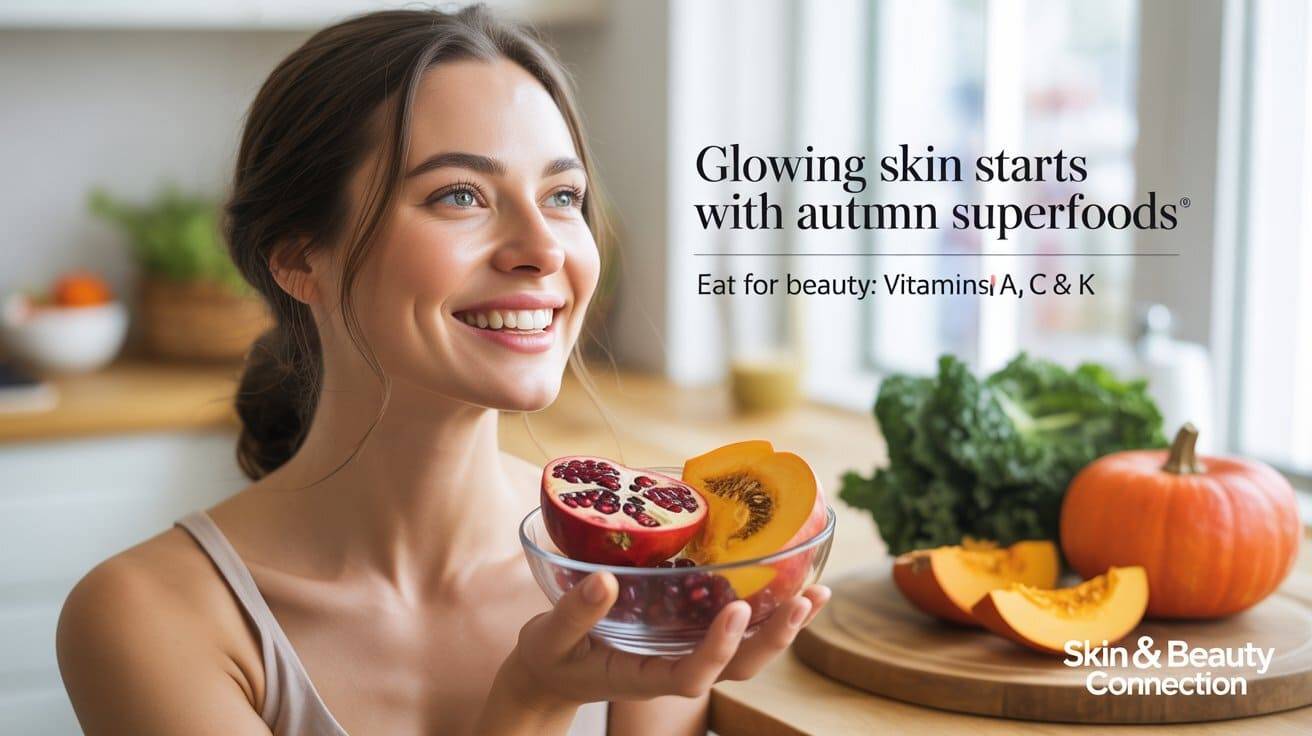
Introduction
Autumn brings cooler air, warm colors—and a rich harvest of vitamin-dense foods that support immunity, skin health, energy levels, and overall well-being. Choosing seasonal, vitamin-rich autumn foods helps you get a fuller spectrum of nutrients (often at lower cost and higher flavor) while supporting local agriculture and reducing food miles. This guide explains the top autumn foods to prioritize, how they help health and beauty, practical ways to include them in meals, and what recent scientific studies say about their benefits. Throughout the text you’ll find SEO-friendly keywords (bolded), a nutrient table, and citations to recent peer-reviewed research and reputable medical sources.
Key points (at a glance)
- Autumn superfoods like pumpkin, sweet potato, pomegranate, persimmon, kale, and cranberries pack vitamins A, C, K, folate, and polyphenols that support skin, immunity, and heart health. PMC+1
- Carotenoids (pro-vitamin A) in pumpkins and sweet potatoes support healthy skin and vision, but high-dose supplements aren’t always safe—get carotenoids from whole foods. MDPIBureau des Suppléments Alimentaires
- Polyphenol-rich fruits like pomegranate and persimmon provide antioxidants linked to reduced oxidative stress and improved skin biomarkers in clinical studies. PMCFrontiers
- Leafy greens (kale, Swiss chard) supply vitamin K, folate, and vitamin C—important for circulation, collagen support, and bone health. Clean Juice
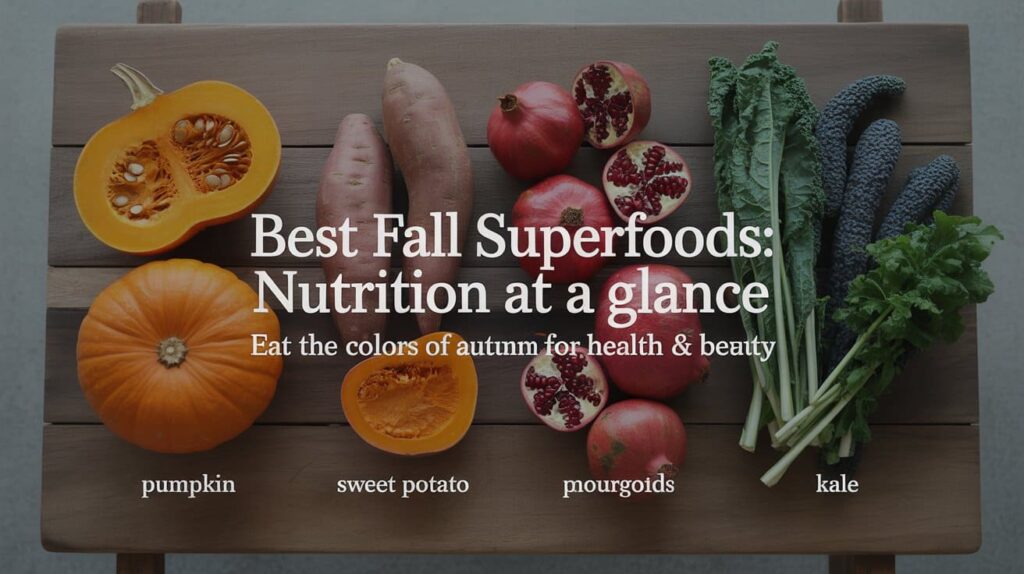
Autumn vitamin-rich foods and why they matter
1. Pumpkin & Winter squashes — rich source of vitamin A (carotenoids)
Pumpkins and winter squashes (butternut, acorn) are iconic fall foods and concentrated sources of beta-carotene and other carotenoids—precursors to vitamin A that support skin renewal, immune responses, and healthy vision. Analytical studies document high levels of β-carotene, α-carotene, lutein and zeaxanthin across pumpkin varieties, making pumpkin an efficient whole-food source of vitamin A activity. For skin and beauty, carotenoids help with cell turnover and can act as internal photoprotectants. PMCMDPI
Practical: Roast cubes with olive oil, blend into soups, or mash into smoothies.
2. Sweet potatoes — a sweet, vitamin-A powerhouse
Sweet potatoes are another autumn staple delivering beta-carotene, fiber, potassium, and vitamin C. They’re easy to use (baked, mashed, or in stews) and provide complex carbohydrates to sustain energy through cooler days. Many clinical nutrition guides list sweet potatoes among the top seasonal foods for supporting skin and immune health. Northside Hospital
3. Pomegranate — polyphenols for skin and heart health
Pomegranate and its polyphenols (punicalagins, anthocyanins) have received substantial research interest for antioxidant, anti-inflammatory, and skin-supportive effects. Reviews and clinical trials show that pomegranate extract can reduce markers of oxidative stress, support lipid profiles, and in some trials improve skin appearance and reduce wrinkle severity when used as an oral supplement or topical component. For beauty, pomegranate supports collagen integrity and may improve skin hydration and texture. PMCHealthline
Practical: Add arils to salads, use juice (sparingly), or sprinkle seeds over grain bowls.
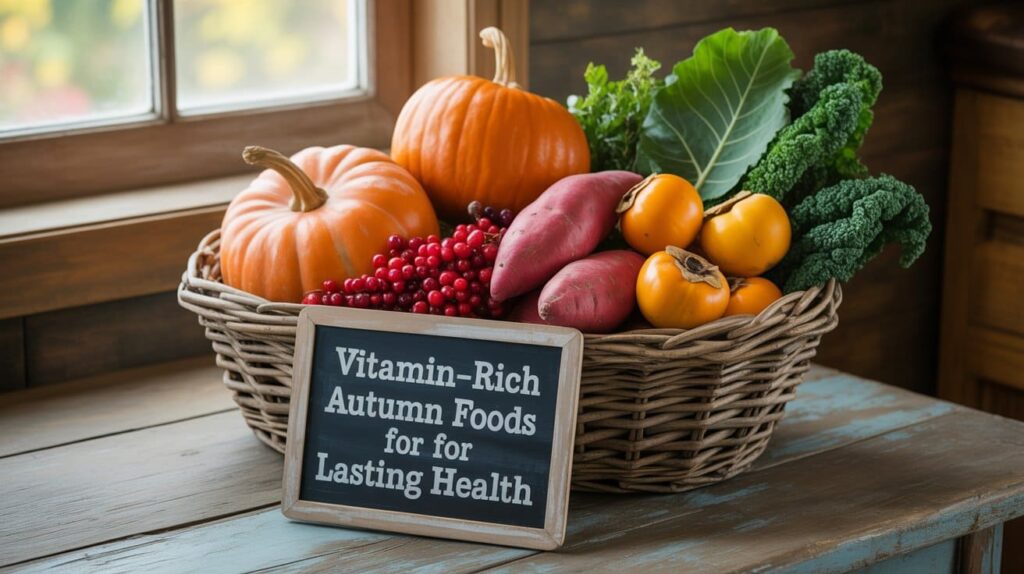
4. Persimmon — seasonal source of vitamin C and antioxidants
Persimmons are a fall fruit abundant in vitamin C, flavonoids, and other antioxidants. Research reviewing persimmon phytochemicals reports substantial antioxidant potential compared with many other common fruits, making persimmon a great autumn choice for immune-supportive vitamin C and skin protection from oxidative damage. FrontiersScienceDirect
Practical: Slice fresh into salads or yogurt, or gently roast for desserts.
5. Kale and dark leafy greens — vitamin K, folate, vitamin C
Kale, Swiss chard, and collard greens are available into autumn and provide vitamin K (important for circulation and bone health), folate for cell division, and vitamin C for collagen synthesis. Regular intake contributes both to internal health and to more resilient, youthful-looking skin. Clean Juice
Practical: Lightly sauté, add to soups, or blend into green smoothies.
6. Cranberries and berries — anthocyanins and vitamin C
Cranberries (fresh or unsweetened) and autumn berry varieties provide anthocyanins and vitamin C. These polyphenols are linked to antioxidant protection, urinary tract health, and improved microcirculation—factors that influence skin tone and systemic health. EatingWell
7. Pumpkin seeds, nuts, and mushrooms — micronutrient support
Pumpkin seeds (magnesium, zinc), walnuts (omega-3 precursors), and many mushrooms available in autumn contribute zinc, selenium, B vitamins, and trace minerals essential for skin repair, hair growth, and immune competence. Including a handful of seeds or nuts daily is an easy nutrition win. EatingWell
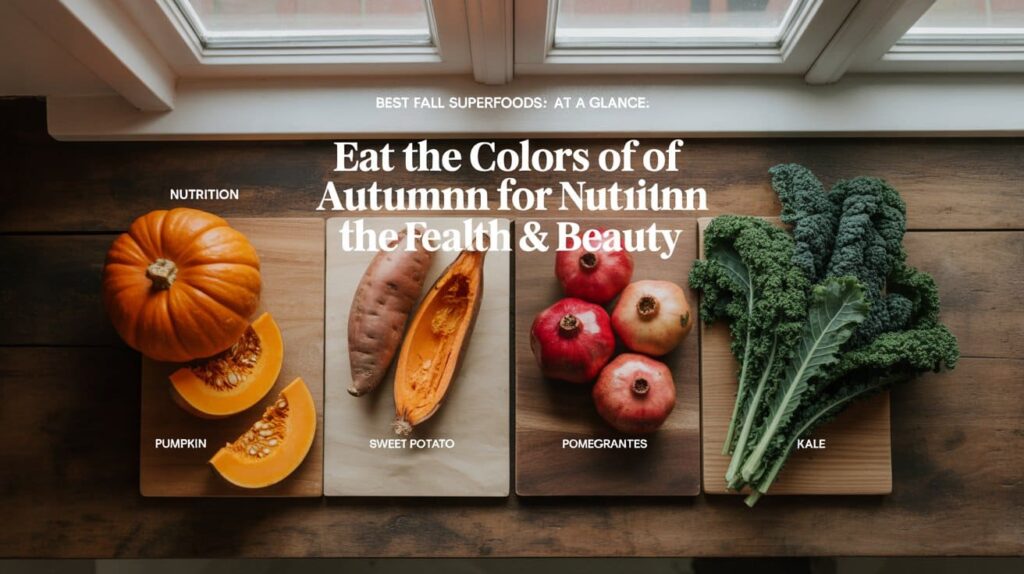
Table — Vitamin highlights of top autumn foods (per typical serving)
| Food | Key vitamins/minerals (not exhaustive) | What it supports |
|---|---|---|
| Pumpkin (1 cup cooked) | Beta-carotene (pro-vitamin A), vitamin C, potassium. PMC | Skin renewal, vision, immunity |
| Sweet potato (1 medium) | Beta-carotene, vitamin C, potassium, fiber. Northside Hospital | Skin, digestion, blood sugar balance |
| Pomegranate (1 cup arils) | Polyphenols (punicalagin), vitamin C, fiber. PMC | Antioxidant defense, collagen support |
| Persimmon (1 medium) | Vitamin C, flavonoids, fiber. Frontiers | Immune health, antioxidant protection |
| Kale (1 cup raw) | Vitamin K, vitamin C, folate, beta-carotene. Clean Juice | Bone health, clotting, skin collagen |
| Cranberries (1/2 cup) | Anthocyanins, vitamin C, polyphenols. EatingWell | Antioxidant, urinary tract health |
| Pumpkin seeds (1 oz) | Zinc, magnesium, vitamin E | Skin repair, sleep, metabolism |
Notes: nutrient content varies by variety, soil, and preparation. Table entries reference recent analyses and reviews cited in the text. MDPIPMC
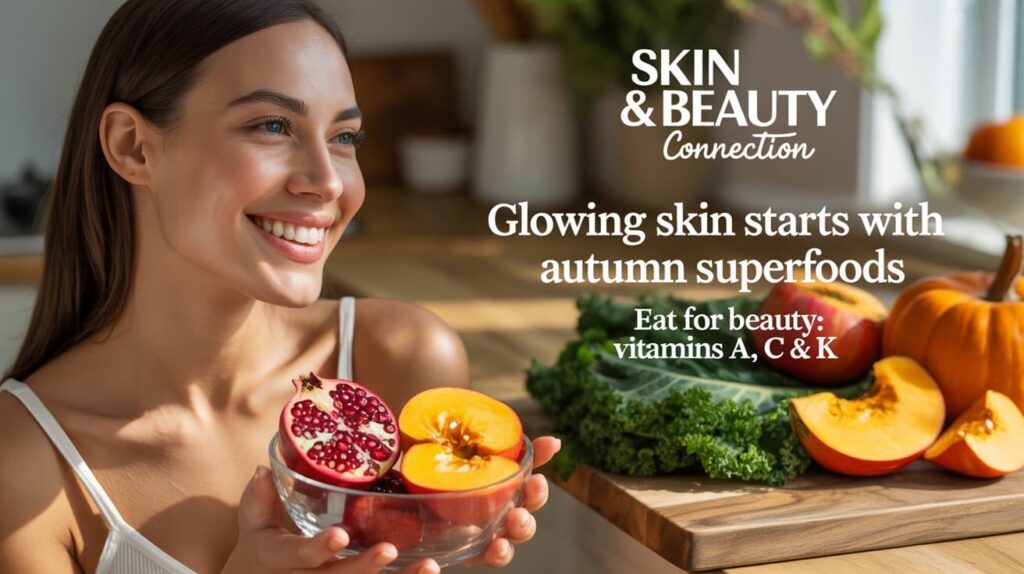
Evidence from recent studies (what the science says)
- Carotenoids in pumpkins and squashes: Analytical and review articles (2023–2025) have characterized the carotenoid profiles of pumpkins and winter squashes, confirming significant β-carotene that contributes to dietary vitamin A activity when consumed as whole foods. These papers emphasize food-based carotenoids rather than high-dose supplements. PMCMDPI
- Pomegranate polyphenols: Comprehensive reviews and clinical trials show pomegranate constituents reduce lipid peroxidation and increase total antioxidant capacity, with some trials reporting improved skin parameters after supplementation. Emerging work (2022–2024) also explores punicalagin as a nutraceutical for cognitive and skin health. PMCScienceDirect
- Persimmon antioxidant potential: Food-science reviews (2022–2025) highlight persimmon’s high antioxidant activity compared to many temperate fruits and describe benefits for metabolic markers in experimental models; human data indicate persimmon contributes meaningfully to vitamin C intake where eaten seasonally. FrontiersScienceDirect
- Leafy greens & vitamin K: Nutrition coverage notes kale and similar greens as top dietary sources of vitamin K and folate, nutrients linked to vascular health and collagen formation. Clean Juice
These citations include peer-reviewed articles and reputable public health references—chosen to show cross-regional research (Asia, Europe, North America) and recent analyses (2022–2025). PMC+1FrontiersMDPI
Practical tips — how to eat for lasting health and beauty this autumn
- Eat the rainbow daily: Aim for orange (pumpkin, sweet potato), red (pomegranate, cranberries), dark greens (kale), and purple (berries) across meals to cover carotenoids, vitamin C, K, and polyphenols.
- Cook smart: Lightly roasting pumpkins and sweet potatoes increases palatability and can make carotenoids more bioavailable when eaten with a little healthy fat (olive oil). Avoid overcooking greens to preserve vitamin C.
- Use whole foods over supplements: Whole fruits and vegetables deliver fiber and complex phytochemicals. Note that certain high-dose supplements (e.g., isolated beta-carotene) have safety concerns for some groups (e.g., smokers), so prioritize food sources and consult a clinician before supplementing. Bureau des Suppléments Alimentaires
- Pair vitamin C with iron: Add pomegranate or persimmon to legume dishes to improve non-heme iron absorption and support skin and energy.
- Snack on seeds: Pumpkin seeds offer zinc and vitamin E—micronutrients that support wound healing and hair/skin health.
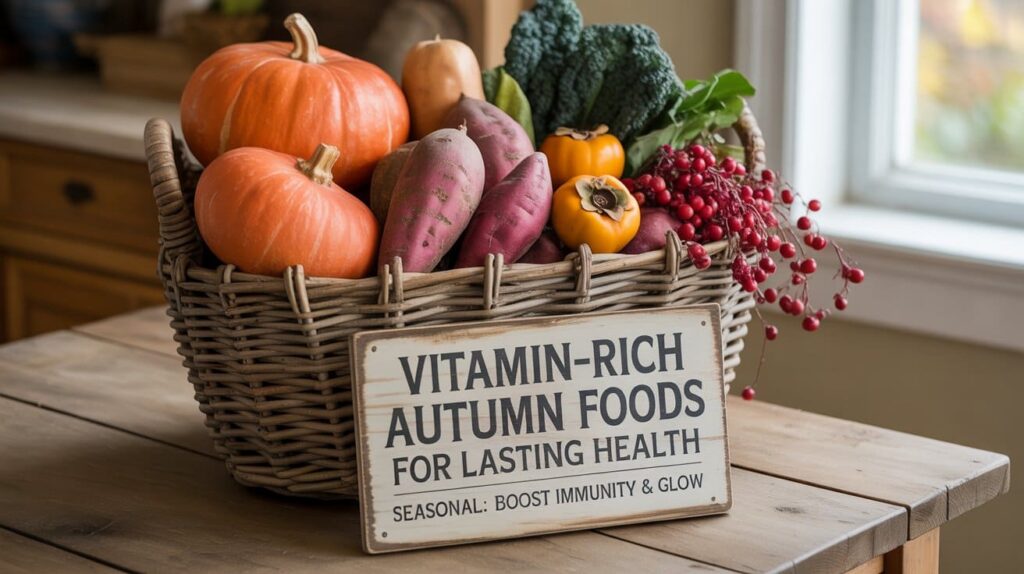
A short note on safety and supplements
While autumn foods provide concentrated vitamins and antioxidants, supplement safety matters. For example, public health reviews highlight risks linked to high-dose single nutrient supplements (such as beta-carotene in smokers) and emphasize food-first approaches. If you consider supplements (vitamin D, a multivitamin, or targeted antioxidants), discuss dosage and interactions with your healthcare provider. Bureau des Suppléments Alimentaires
Conclusion
Autumn is a bountiful season for vitamin-rich foods that support long-term health and radiant skin. Prioritize pumpkins and winter squashes, sweet potatoes, pomegranate, persimmon, kale, and cranberries to get a powerful mix of vitamin A (carotenoids), vitamin C, vitamin K, and polyphenols. These foods not only taste seasonal and comforting but—according to recent peer-reviewed studies and authoritative nutrition sources—deliver nutrients that assist immunity, protect skin from oxidative stress, and support overall aging healthfully. For the best results, emphasize whole foods, varied preparation methods, and food combinations that enhance nutrient absorption.
SEO keywords (use in meta/title/description): autumn superfoods, vitamin-rich fall foods, pumpkin beta-carotene, pomegranate antioxidants, persimmon vitamin C, best fall foods for skin, seasonal nutrition autumn, foods for immunity in fall
Selected references and further reading
- Grassino AN, et al. Carotenoid Content and Profiles of Pumpkin Products and … (2023). PMC. PMC
- Benedetti G, et al. An Overview of the Health Benefits, Extraction Methods … (2023) — pomegranate polyphenol review. PMC. PMC
- Hosseininejad S, et al. Valorization of Persimmon Fruit Through the Development … (Frontiers, 2022). Frontiers
- Gavril RN, et al. Pumpkin and Pumpkin By-Products: A Comprehensive … (MDPI, 2024). MDPI
- National Institutes of Health — Office of Dietary Supplements. Vitamin A and Carotenoids Fact Sheet (Health Professional) (2025). Bureau des Suppléments Alimentaires
- Healthline summary: 9 Impressive Health Benefits of Pumpkin (for consumer-facing context). Healthline






